How to Choose Framework for Web Development: An In-depth Analysis
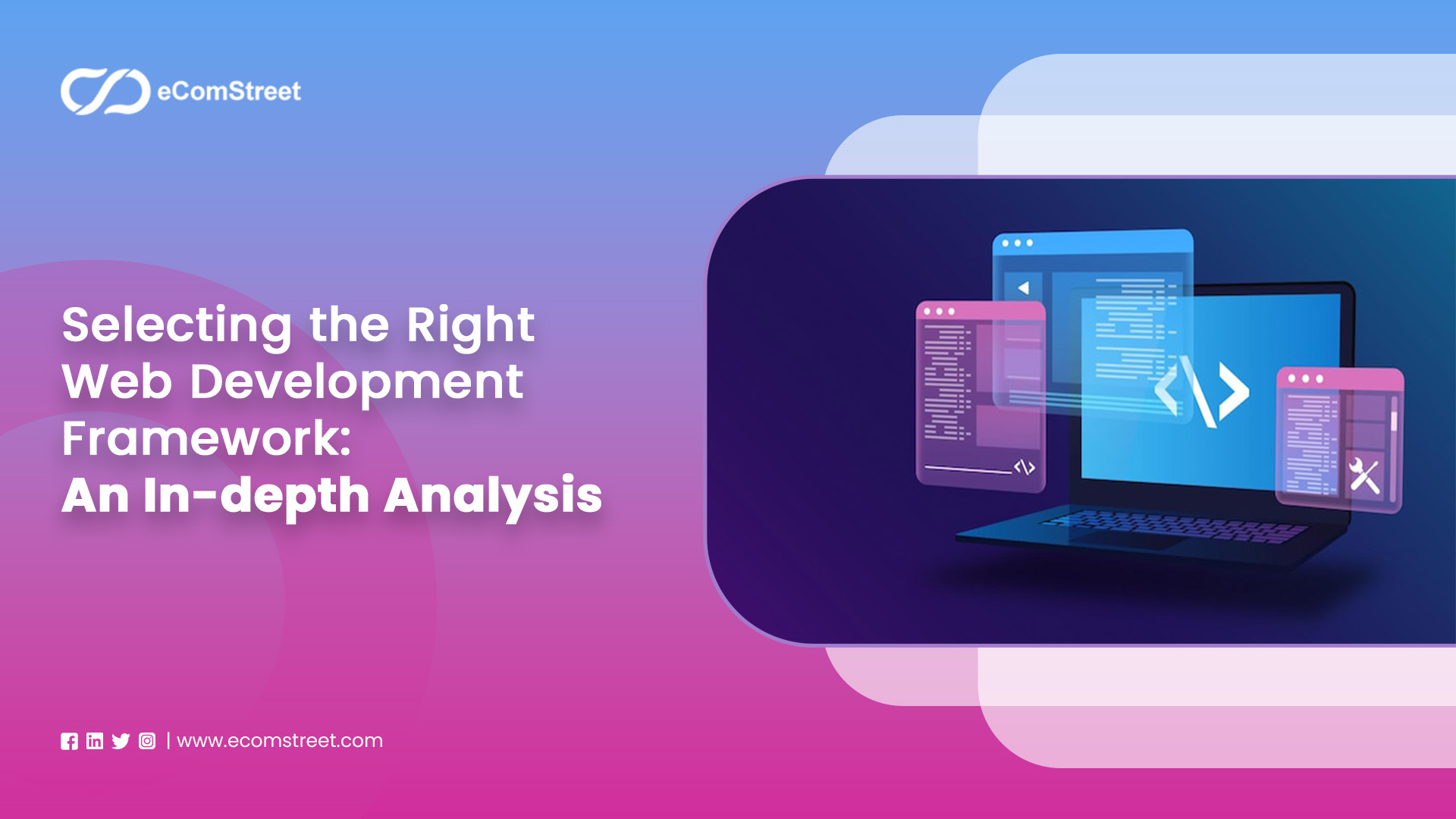
An alternative solution is to buy a soup mix from the grocery shop and get it done instantly. This is a much easier and quicker process than the traditional one.
The web development framework is like a soup mix for software developers. These web programming frameworks are the pre-built tools that can be used to build a mobile and web app. Developers can still add their touch to the development process by adding their code for unique features and custom-made as per the project requirements.
Stay tuned to learn more about the web development framework, its meaning, architecture, components, some of the popular website frameworks, and much more.
Understanding Best Web Application Frameworks
A web development framework is software that lets you make and run web apps. This means you don't have to write code alone and waste time checking it for mistakes and bugs.
When the web was first being built, all apps were hand-coded, and only the person who made them could change or release them. Web tools made it easy to get out of this mess. The trouble of changing an application's structure has been handled since 1995 by the appearance of general performance. That's when programming languages made just for the web came along. Now, both primary and interactive web pages work well with their range. No matter what you need to do, you can pick one website template that does it all or combine a few.
The Most Popular Web Development Frameworks
Backend Frameworks
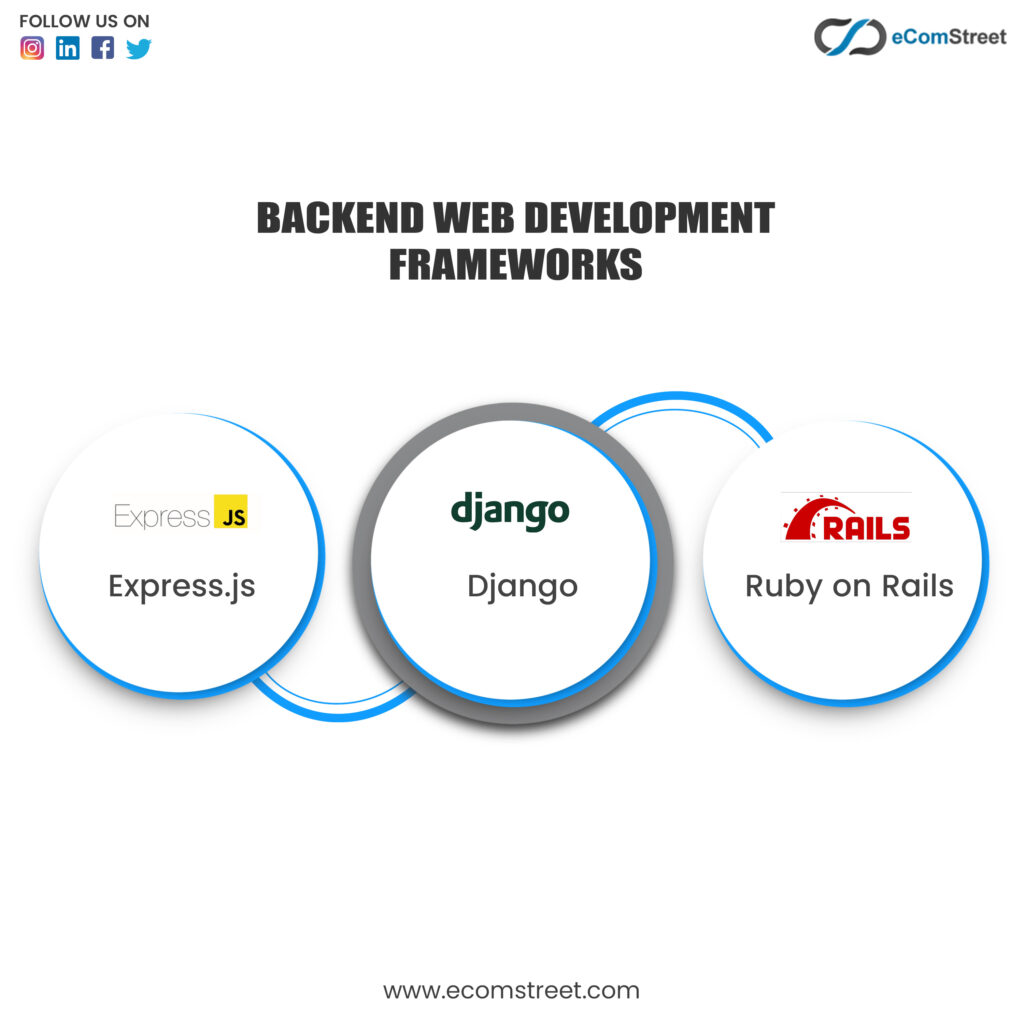
Frameworks for the back end run on the computer. They are in charge of making server systems that are well-structured, safe, and flexible. Backend frameworks give you tools that make the whole development process much easier so you can focus on ideas and features that people have asked for.
Frontend Frameworks
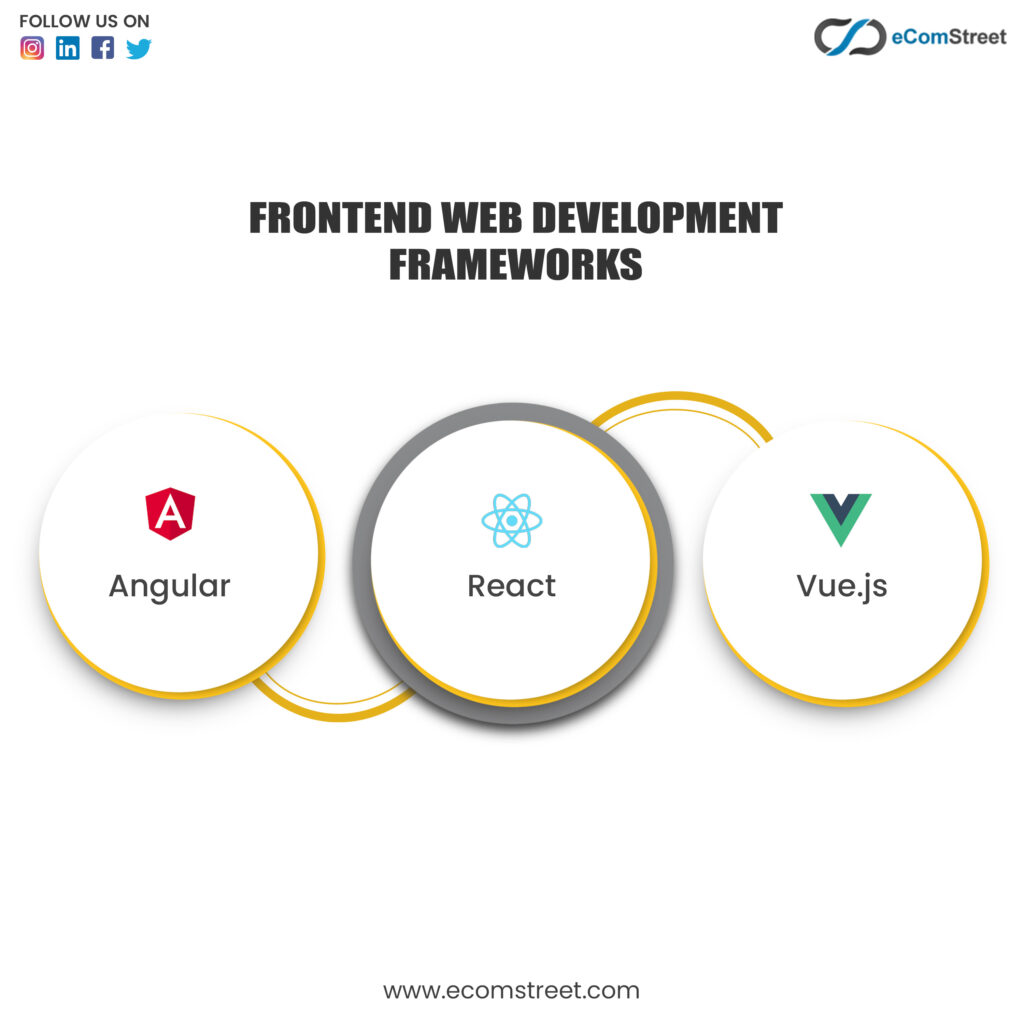
Web development companies can use frontend frameworks to build site code, make single-page apps, and make user experiences that work in browsers or improve them differently.
Developers can use these frameworks to add new features and improve the user experience. Websites and apps will look good on all systems and browsers so everyone can use them.
Classifications of Web Programming Framework Architecture
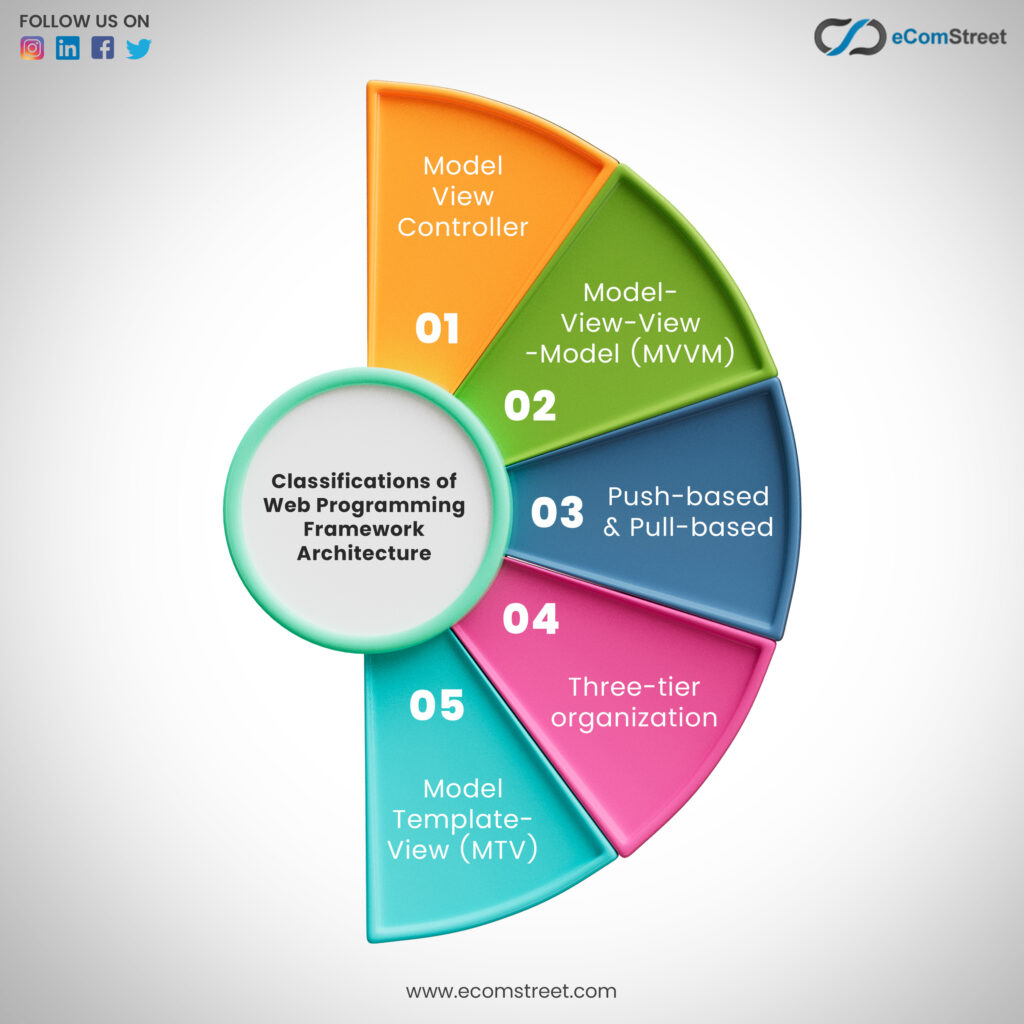
A framework architecture is like the foundation of your web development framework; it shows how all of its parts fit together. It is also in charge of all the functions between layers that interact with each other in some way. Below, we'll talk about 5 main framework architectures that are often used when building web applications.
Model View Controller
MVC stands for Model, View, and Controller. It is one of the most accessible and famous framework designs because it sets up a three-tier structure for web apps. Each part is responsible for specific tasks and actions based on how the website is set up and how things work inside the app.
So many developers use the MVC design because it helps them ensure that different data types align with their standards. Experts think it's a good idea because it reuses code, lets you use different APIs, and uses modularized code.
Model-View-View-Model (MVVM)
The view layer is a master model in the Model-View-View-Model web development. This way, the data objects in the model layer are changed into different blocks. Data linking is also much easier because the view layer handles all user requests directly.
Push-based & Pull-based
Actions are used in the push-based web app structure type to make the web app do a sure thing. You could say it "plunges" all the data into a view layer to get the desired effect. This design style can be seen in Symfony, Ruby on Rails, CodeIgniter, Django, and Spring MVC.
"Pull-based," also called "component-based," is a different type of this system. This architecture starts all its processes from the view layer instead of the pushed-based architecture. This is because the architecture "drags" all the results from the controls to the view layer. Web frameworks like JBoss, Tapestry, Lift, JavaServer, and Micro use these building blocks.
Three-tier organization
As soon as the idea of a web app came up, most web application platforms started using this fundamental web design. It has three main parts: the client, the server, and the database, which is generally a relational database.
The server handles most of the business code and is where the web application lives. It responds to HTTP and database questions from clients and gives them the results they need. The client uses a web browser to view and navigate the web application through the generated code. The client views the result from the server side.
Model-Template-View (MTV)
The Model-View-Controller (MVC) online architecture resembles the Model-View-Controller (MVC) design. To begin, they both have the Model part, where the code controls the database and data. Both have a " View " feature that shows the person the info. With MTV, the template is the only one to decide what output format the user will see.
MVC and MTV are two different ways to build a web app. You need to write specific pieces of code with MVC, but MTV will do this for you. To get a list of all the names of your registered users, for example, you would have to write code for the view layer, ask the database for the list, and then link it to the right URL. That's not like MTV at all. Now, the system does all of these things for you; all you have to do is tell it what kind of info you want to get and show.
Comparative Analysis of Top Web Development Frameworks
Frontend Web Development Frameworks:
Angular
- Language: TypeScript
- Developed by Google
- Architecture: Uses a full-fledged MVC architecture.
- Learning Curve: The learning curve is steeper due to its comprehensive feature set.
- Scalability: Well-suited for large-scale applications.
- Community Support: Strong community support and regular updates.
React
- Language: JavaScript (JSX)
- Developed by: Facebook
- Architecture: Component-based architecture.
- Learning Curve: Easier to pick up, especially for those familiar with JavaScript.
- Scalability: Great for building dynamic, interactive UIs.
- Community Support: Large and active community, a vast ecosystem of libraries.
Vue.js
- Language: JavaScript
- Developed by: Evan You
- Architecture: Progressive framework with an incrementally adaptable architecture.
- Learning Curve: Easy to integrate into projects, suitable for beginners.
- Scalability: Works well for small to medium-sized projects.
- Community Support: Growing community, simplicity, and ease of integration.
Backend Web Development Frameworks:
Express.js
- Language: JavaScript
- Developed by: Node.js foundation
- Architecture: Minimalist, unopinionated framework for Node.js.
- Learning Curve: Straightforward, suitable for beginners.
- Scalability: Highly scalable, mainly when used with Node.js.
- Community Support: One of the most popular Node.js frameworks, extensive community support.
Django
- Language: Python
- Developed by: Django Software Foundation
- Architecture: Follows the Model-View-Controller (MVC) architectural pattern.
- Learning Curve: Generally straightforward, especially for those familiar with Python.
- Scalability: Known for its scalability and flexibility.
- Community Support: Strong community support and comprehensive documentation.
Ruby on Rails
- Language: Ruby
- Developed by David Heinemeier Hansson
- Architecture: Follows the Model-View-Controller (MVC) architectural pattern.
- Learning Curve: Slightly steeper for beginners in comparison to Express.js.
- Scalability: Efficient for rapid development and scalable for medium-sized projects.
- Community Support: Active community is known for its developer-friendly conventions.
Essential Things to Consider About When Picking a Modern Web Development Framework
Project Requirements and Goals
Before using web frameworks, you must be clear about your project's needs and what you want it to achieve. Figure out what features you want to build, who to make them for, and how big the project will be. This will help you narrow down your options, select a system that fits your needs, and give you the tools you need to build the features you want.
Learning Curve and Documentation
Each web programming framework has a different learning curve based on language, design, and level of complexity. Think about how good your development team is at programming languages and how well they know the framework's concepts. Check the framework's instructions for quality and completeness, as well as the available learning materials like lessons and sample projects. Your team will be able to get up to speed faster and be more productive with a well-documented system that has a low learning curve.
Community Support and Ecosystem
It is beneficial for a website framework to have a strong and busy community around it. It shows how stable, popular, and long-lasting the structure is. A strong community can help each other through forums, blog posts, and workshops, and it can also help make third-party tools, plugins, and apps. Check out how big and active the dev framework's community is and whether tools like Stack Overflow replies, GitHub projects, and meetups are easy to find.
Performance and Scalability
It's crucial for a web framework to be fast and scalable, especially for projects that will get a lot of traffic and active users. Find out how the system handles query processing, database access, and caches. Check if it has any features or tools to help you get the best speed and the ability to grow the application as needed. Remember that some systems may work faster right out of the box, while others may need more modifying to perform at their best.
Security and Maintenance
Web application security is essential because loopholes can cause significant problems for your users and business. Check out each framework's built-in security features and how they protect against common web security threats. Also, think about how well the framework has been maintained and updated in the past. Your app needs regular maintenance and improvements to stay safe and up to date.
The Benefits of Using a Website Development Framework
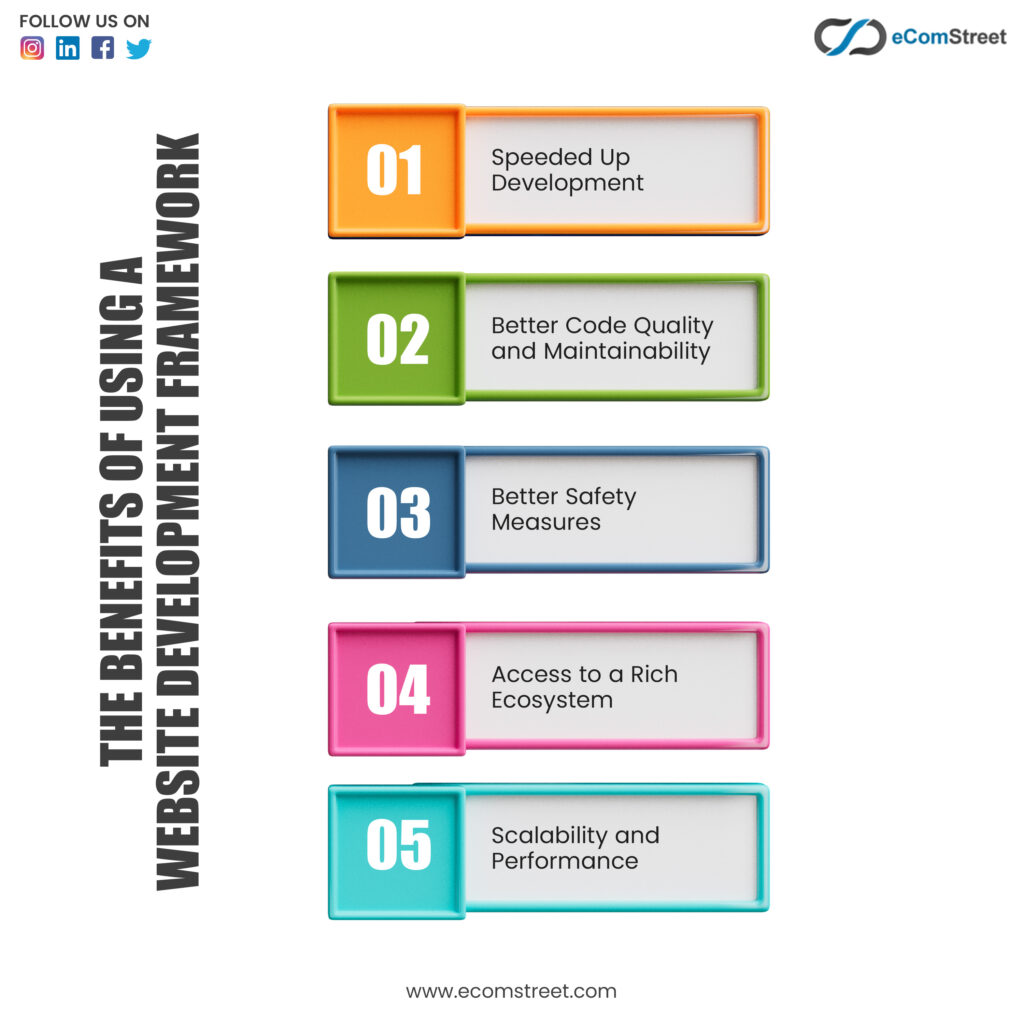
Website frameworks are robust tools that can make building websites a lot easier. They let the dev framework focus on creating unique features and user experiences instead of dealing with low-level technical details by giving them a set of pre-built components, tools, and best practices. In this part, we will talk about the main reasons why you should use a website framework for your next project.
1. Speeded Up Development
One of the best things about using a website framework is that it speeds up development. Web frameworks give you a solid base, so you don't have to start from scratch for everyday jobs like routing, database access, and form handling. This lets developers focus on writing high-level code and adding special features to the project. This cuts the time it takes to get the product to market by a significant amount.
2. Better Code Quality and Maintainability
With web frameworks, structure and design are always the same, which makes code cleaner and easier to manage. Developers can make flexible apps that separate issues by sticking to well-known design techniques and best practices. This makes it easier to find problems, fix them, and add to and change the app in the future.
3. Better Safety Measures
Security is integral to building websites, and most development frameworks have built-in ways to keep apps safe from common threats. Developers can make secure apps without learning much about web security using these built-in features. Furthermore, web platforms are constantly updated to fix new security holes. This makes sure that your application stays safe over time.
4. Access to a Rich Ecosystem
There are often a lot of third-party tools, apps, and add-ons that work well with a popular web platform. These tools can make your app much more valuable and save time by giving ready-made answers to different problems. A strong group behind a web framework can also help you with your project by giving you support, advice, and ideas.
5. Scalability and Performance
Website frameworks are made to handle different amounts of traffic and user activity, which makes it easier to create apps that many people can use. They usually have tools and features that make them run faster, like caching systems and quick database access. Professional developers can create apps that can grow with the needs of the business by using a web platform.
The Final Thoughts
If you have made it this far, you’ve been introduced to the web development framework, its components, architecture, benefits, and more. So, if you are planning to recruiting a software developer with hands-on experience for more than a decade, feel free to contact eComstreet. We have various web and app development services across multiple industries.

Author
Manas Singh
Designation : Sr.Full Stack Developer
Having 11+ years of experience in application development domain, now he is working on Web3 and blockchain technology. He is having sound knowledge of Solidity language and building smart contracts.